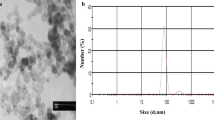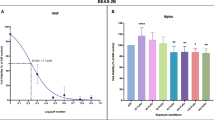Abstract
FA (formaldehyde) and ACR (acrolein) are common pollutants in environment, which often occur together in air. So, adverse health effects may not only result from their individual toxicity but also from the combined toxicity. While often studied alone, combination effects of these pollutants are inconclusive. Here, we examined the combined cytotoxicity and genotoxicity of FA and ACR on A549 cells based on CCK-8 assay, comet assay, and cytokinesis-block micronuclei assay. FA and ACR mixtures showed significant cytotoxicity and genotoxicity even at NOECs (no observed effect concentrations). Moreover, FA and ACR administrated jointly at doses from NOECs to sub-cytotoxic concentrations demonstrated significant interactions in cytotoxicity, DNA strand breaks, and chromosome damage. Co-exposure to FA and ACR significantly showed a lower responses on DNA strand break and chromosome damage than those expected for additivity, while an opposite result was obtained on cytotoxicity. Taken together, these results indicated that there was significant interactions on cytotoxicity and genotoxicity for FA and ACR, and prolonged exposure to mixtures of FA and ACR below sub-cytotoxic concentrations can produce a serious threat in human’s health.






Similar content being viewed by others
References
Aldini G, Orioli M, Carini M (2011) Protein modification by acrolein: relevance to pathological conditions and inhibition by aldehyde sequestering agents. Mol Nutr Food Res 55:1301–1319
Araldi RP, de Melo TC, Mendes TB, de Sa Junior PL, Nozima BH, Ito ET, de Carvalho RF, de Souza EB, de Cassia Stocco R (2015) Using the comet and micronucleus assays for genotoxicity studies: a review. Biomed Pharmacother 72:74–82
Aydin S, Canpinar H, Undeger U, Guc D, Colakoglu M, Kars A, Basaran N (2013) Assessment of immunotoxicity and genotoxicity in workers exposed to low concentrations of formaldehyde. Arch Toxicol 87:145–153
Cassee F, Stenhuis W, Groten J, Feron V (1996) Toxicity of formaldehyde and acrolein mixtures: in vitro studies using nasal epithelial cells. Exp Toxicol Pathol 48:481–483
Cassee FR, Groten JP, van Bladeren PJ, Feron VJ (1998) Toxicological evaluation and risk assessment of chemical mixtures. Crit Rev Toxicol 28:73–101
Cheah NP, Pennings JL, Vermeulen JP, van Schooten FJ, Opperhuizen A (2013) In vitro effects of aldehydes present in tobacco smoke on gene expression in human lung alveolar epithelial cells. Toxicology In Vitro 27:1072–1081
Daly MJ (2012) Death by protein damage in irradiated cells. DNA Repair (Amst) 11:12–21
David R, Ebbels T, Gooderham N (2016) Synergistic and antagonistic mutation responses of human MCL-5 cells to mixtures of benzo[a]pyrene and 2- amino-1-methyl-6-phenylimidazo[4,5-b]pyridine: dose-related variation in the joint effects of common dietary carcinogens. Environ Health Perspect 124:88–96
Feron VJ, Groten JP, Jonker D, Cassee FR, van Bladeren PJ (1995) Toxicology of chemical mixtures—challenges for today and the future. Toxicology 105:415–427
Fornace AJ (1982) Detection of DNA single-strand breaks produced during the repair of damage by DNA-protein cross-linking agents. Cancer Res 42:145–149
Grafström RC (1990) In vitro studies of aldehyde effects related to human respiratory carcinogenesis. Mutat Res 238:175–184
Grafstrom RC, Fornace AJ, Autrup H, Lechner JF, Harris CC (1983) Formaldehyde damage to DNA and inhibition of DNA repair in human bronchial cells. Science 220:216–218
Gueranger Q, Li F, Peacock M, Larnicol-Fery A, Brem R, Macpherson P, Egly JM, Karran P (2014) Protein oxidation and DNA repair inhibition by 6-thioguanine and UVA radiation. J Investig Dermatol 134:1408–1417
Katsifis SP, Kinney PL, Hosselet S, Bums FJ, Christie NT (1996) Interaction of nickel with mutagens in the induction of sister chromatid exchanges in human lymphocytes. Mutat Res 359:7–15
Kawanishi M, Matsuda T, Yagi T (2014) Genotoxicity of formaldehyde: molecular basis of DNA damage and mutation. Front Environ Sci. https://doi.org/10.3389/fenvs.2014.00036
Klaric MS, Darabos D, Rozgaj R, Kasuba V, Pepeljnjak S (2010) Beauvericin and ochratoxin a genotoxicity evaluated using the alkaline comet assay: single and combined genotoxic action. Arch Toxicol 84:641–650
Lam C-W, Casanova M, Heck HA (1985) Depletion of nasal mucosal glutathione by acrolein and enhancement of formaldehyde-induced DNA-protein cross-linking by simultaneous exposure to acrolein. Arch Toxicol 58:67–71
Li L, Jiang L, Geng C, Cao J, Zhong L (2008) The role of oxidative stress in acrolein-induced DNA damage in HepG2 cells. Free Radic Res 42:354–361
Li X, Liu L, Wang H, Chen J, Zhu B, Chen H, Hou H, Hu Q (2017) Simultaneous analysis of six aldehyde-DNA adducts in salivary DNA of nonsmokers and smokers using stable isotope dilution liquid chromatography electrospray ionization-tandem mass spectrometry. J Chromatogr B Anal Technol Biomed Life Sci 1060:451–459
LoPachin RM, Gavin T (2014) Molecular mechanisms of aldehyde toxicity: a chemical perspective. Chem Res Toxicol 27:1081–1091
Moghe A, Ghare S, Lamoreau B, Mohammad M, Barve S, McClain C, Joshi-Barve S (2015) Molecular mechanisms of acrolein toxicity: relevance to human disease. Toxicol Sci 143:242–255
Nardini M, Finkelstein EI, Reddy S, Valacchi G, Traber M, Cross CE, van der Vliet A (2002) Acrolein-induced cytotoxicity in cultured human bronchial epithelial cells. Modulation by alpha-tocopherol and ascorbic acid. Toxicology 170:173–185
Obahiagbon FIOI (2015) Formaldehyde a review of occurrence, chemical characteristics, exposures, metabolism, kinetics and health effects in man and animals.pdf
OECD (2014) OECD guidelines for the testing of chemicals:in vitro mammalian cell micronucleus test(TG 487). Organisation for Economic Co-operation and Development, pp 1–26
Pang X, Lewis AC (2011) Carbonyl compounds in gas and particle phases of mainstream cigarette smoke. Sci Total Environ 409:5000–5009
Regazzoni LG, Grigoryan H, Ji Z, Chen X, Daniels SI, Huang D, Sanchez S, Tang N, Sille FC, Iavarone AT, Williams ER, Zhang L, Rappaport SM (2017) Using lysine adducts of human serum albumin to investigate the disposition of exogenous formaldehyde in human blood. Toxicol Lett 268:26–35
Rui L, Song LZ, Yan Q, Chao YH, Fei YF, Xu Y (2004) Study on the formaldehyde-induced DNA damage with comet assay. Acta Biol Exp Sin 34:262–268
Sakata K, Kashiwagi K, Sharmin S, Ueda S, Irie Y, Murotani N, Igarashi K (2003) Increase in putrescine, amine oxidase, and acrolein in plasma of renal failure patients. Biochem Biophys Res Commun 305:143–149
Shi R, Rickett T, Sun W (2011) Acrolein-mediated injury in nervous system trauma and diseases. Mol Nutr Food Res 55:1320–1331
Stabbert R, Dempsey R, Diekmann J, Euchenhofer C, Hagemeister T, Haussmann HJ, Knorr A, Mueller BP, Pospisil P, Reininghaus W, Roemer E, Tewes FJ, Veltel DJ (2017) Studies on the contributions of smoke constituents, individually and in mixtures, in a range of in vitro bioactivity assays. Toxicol In Vitro 42:222–246
Tang M-S, Wang H-T, Hu Y, Chen W-S, Akao M, Feng Z, Hu W (2011) Acrolein induced DNA damage, mutagenicity and effect on DNA repair. Mol Nutr Food Res 55:1291–1300
Tong Z, Han C, Luo W, Wang X, Li H, Luo H, Zhou J, Qi J, He R (2012) Accumulated hippocampal formaldehyde induces age-dependent memory decline. Age 35:583–596
van Andel I, Schenk E, Rambali B, Wolterink G, van de Werken G, Stevenson H, van Aerts LAGJM, Vleeming W (2003) The health- and addictive effectes due to exposure to aldehydes of cigarette smoke. Part 1; Acetaldehyde, Formaldehyde, Acrolein and Propionaldehyde, Bilthoven
van Gent DC, Hoeijmakers JH, Kanaar R (2001) Chromosomal stability and the DNA double-stranded break connection. Nat Rev Genet 2:196–206
Wang G-W, Guo Y, Vondriska TM, Zhang J, Zhang S, Tsai LL, Zong NC, Bolli R, Bhatnagar A, Prabhu SD (2008) Acrolein consumption exacerbates myocardial ischemic injury and blocks nitric oxide-induced PKCε signaling and cardioprotection. J Mol Cell Cardiol 44:1016–1022
Weber F, Freudinger R, Schwerdt G, Gekle M (2005) A rapid screening method to test apoptotic synergisms of ochratoxin A with other nephrotoxic substances. Toxicology In Vitro 19:135–143
Yang Q, Hergenhahn M, Weninger A, Bartsch H (1999) Cigarette smoke induces direct DNA damage in the human B-lymphoid cell line Raji. Carcinogenesis 20:1769–1775
Yang D, Xi Z, Zhang H, Li G, Liang Z (2000) Effect of typical aldehyde pollutants on the DNA damage of spleen lymphocytes of mice. J Hyg Res 29:30–32
Acknowledgements
We thank Dr. Xuemei Cheng (Shandong Center for Disease Control and Prevention, China) for the technical guidance in the Comet assay and micronucleus assay.
Author information
Authors and Affiliations
Corresponding authors
Ethics declarations
Conflict of interest
The authors declare that they have no conflicts of interest.
Additional information
Responsible editor: Philippe Garrigues
Rights and permissions
About this article
Cite this article
Zhang, S., Chen, H., Wang, A. et al. Combined effects of co-exposure to formaldehyde and acrolein mixtures on cytotoxicity and genotoxicity in vitro. Environ Sci Pollut Res 25, 25306–25314 (2018). https://doi.org/10.1007/s11356-018-2584-z
Received:
Accepted:
Published:
Issue Date:
DOI: https://doi.org/10.1007/s11356-018-2584-z




